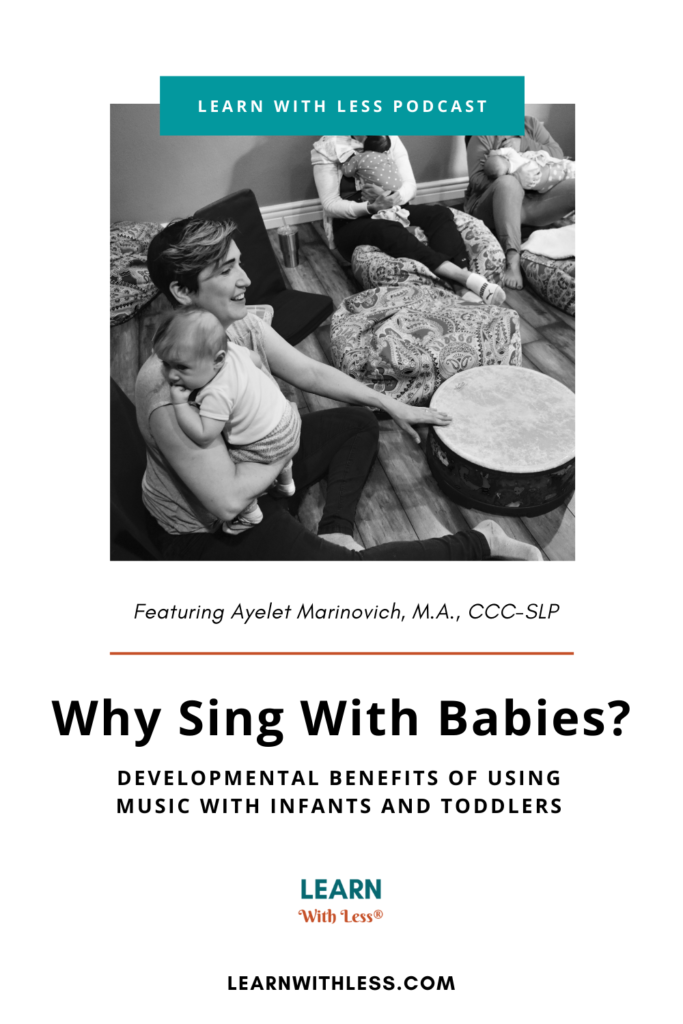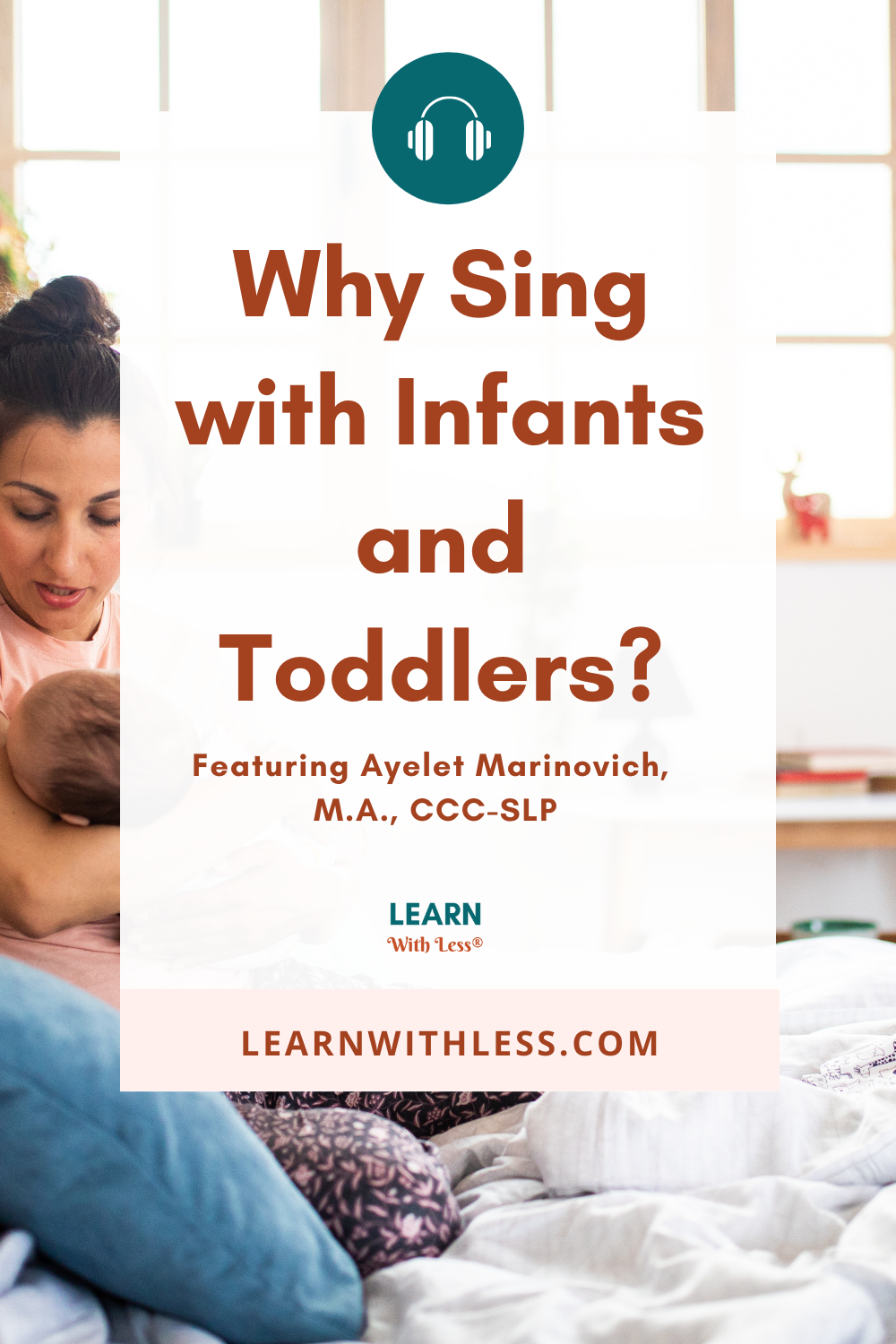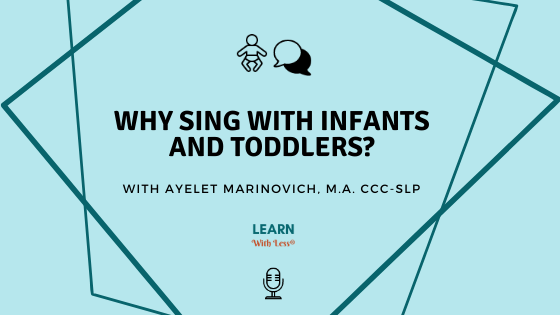Developmental Benefits of Using Music With Babies

This week, I’m bringing back the very first episode of the Learn With Less® podcast. We’ve been going strong for 5 and a half years now, and whether you’re brand new to Learn With Less or you’ve been in our community for a while, I want to bring this information to the forefront of your mind again.
It’s so exciting to revisit content I created years ago, both because the heart of that content is still so very relevant today (which is of course why I’m sharing it with you again), and also because it helps me see how far I’ve come as a content creator, a parent educator, a business owner, and a human!
I remember sitting down to record this episode originally, after having led my “caregiver & me” classes for several years, and thinking that it was time to experiment with form. You’ll see that in these early episodes, the podcast was really very much an extension of our classes.
These days, I refer to the topic in today’s episode as related to third pillar of Learn With Less®, which is SING. If you don’t know yet, we have 4 pillars, which are play, talk, sing, and move! I’ll step aside for the actual episode in just a moment, but I do want to encourage you to explore all the resources on our website, which is now learnwithless.com. If you’re curious about our Learn With Less® “caregiver and me” classes, you are invited to head to learnwithless.com/democlass where you can sign up to watch a short pre-recorded version of that experience! I can’t wait to hear what you think.
** The information, songs, and ideas listed herein are protected by copyright. To license the materials used in the Learn With Less® curriculum, please apply here! **
Helpful Resources Related To This Episode
Attend a free, pre-recorded snippet of a Learn With Less® “caregiver & me” class
Download our free Infant/Toddler Development Blueprint, outlining major areas of learning and development in the first three years of life, and how you can support them using our four pillars of play, talk, sing, & move
Learn With Less® Bundle: get our favorite infant and toddler development resources (save 70%)! Discover how to support & connect with your tiny human, without having to buy a single toy. Includes our bestselling books, our family music album, a full Learn With Less® “caregiver & me” class, and a caregiver handout outlining everything we covered so you can do it again and again at home!
Learn With Less® Facilitator Training & Certification Program: Use your existing skills as an educator or therapist to serve families holistically with a high quality program that will provide lasting impact! Apply now to become a licensed facilitator Learn With Less®.
Learn With Less® “Caregiver & Me” Classes: the magic of Learn With Less® lies in the communal aspect of coming together with our resources, in community with other families. Join us for a virtual or in-person class led by a licensed facilitator near you!
Original version of the first Learn With Less® podcast episode, Why Sing?
How to make a homemade rain stick, our corresponding blog post
Text Transcript of this Episode
Hi, I’m Ayelet Marinovich, your host of the [Learn With Less®] podcast!
This is the very first episode of [Learn With Less®], a family enrichment program for caregivers and infants. Each week, we get together to sing a few songs, discuss some ideas for play, and outline some insight about infant and toddler development. The idea is this: whether you’re a parent or caregiver, working a job, caregiving full-time, whether your baby is following a typical progression of development or not, this is time for you to be together and to feel like you’re doing something good for and with your baby.
Please do follow your baby’s lead. If you can get through the entirety of the episode while sitting in one place together, that’s great! If not, keep it on in the background for as long as it’s entertaining, and you may find yourselves coming back to it. But please don’t force your child to sit through something that’s not being enjoyed – we’re trying to promote shared interactive experiences! You can always come back another time or another week!
I am a speech-language pathologist and I specialize in work with very young children, but this is not to be confused with “speech therapy.” This is, what I call, “family enrichment!” For more information, links to further reading, and to learn more about me, please visit my website.
Let’s start by using our bodies, tapping to the beat. As you become familiar with the songs, sing along and please sing them without me throughout your week! Don’t worry if you don’t consider yourself musical, or if rhythm doesn’t feel like it comes “naturally” to you – this is about the time you spend with your baby, doing something together! We’ll talk more about why it’s so beneficial later in the episode and in weeks to come.
Hello everybody, hello everybody, it’s nice to see you here today
Hello everybody, hello everybody, it’s nice to see you here
We can start by saying hello to the people who are with us.
Hello to Ayelet, hello to the singers, hello, hello, hello, hello
Hello to the baby, hello to the grown-ups, hello, hello, hello
Since I don’t know your name, I’ll help you sing the song and you can fill it in! Ready? Let’s practice once first.
Hello to (your baby’s name), hello to (your name), hello, hello, hello, hello
Hello everybody, hello everybody, hello, hello, hello
Ok, we’ll try it again, without me prompting you!
Hello to _____, hello to ______, hello, hello, hello, hello
Hello everybody, hello, everybody, hello, hello, hello!
Great job! That’s our “hello song,” and we’ll start with some version of it each time. This is a nice way to introduce the idea of “ritual” to your baby. I think we tend to get pretty caught up with the idea of babies becoming accustomed to routines, but I like to think of rituals as special things we can do within our families. More on that another time, though.
So, I’m going to be using a mix of “real” instruments, and things you can likely find in your home or can easily create out of items in your home. I will be starting a section of “DIY’s” on my website, and a Pinterest board for even more ideas.
This is a “rain stick” I made out of an empty round spice jar and and some dry rice. The lid stays on (with an additional layer of baby-proofing duct tape for peace of mind), but can be pushed or manipulated by baby quite easily.
Rain, rain, go away, Come again another day
Little Johnny wants to play, so rain, rain, go away.
If you already have a little Johnny at home, how lucky that this song is already personalized for you! If not, let’s take the necessary steps to do that!
Rain, rain, go away, come again another day
My sweet baby wants to play so rain, rain, go away
Ok, this time, you can add your baby’s name!
Rain, rain, go away, come again another day
Little _____ wants to play so rain, rain go away
Who else might want to play? I do!
Rain, rain, go away, come again another day
Ayelet wants to play so rain, rain go away
Why don’t you come up with another person who might want to play (yourself, for instance)
Rain, rain, go away, come again another day
_______ wants to play so rain, rain go away
You know, on second thought, I think it might be fun to go outside and play IN the rain, as long as we’re warm and cozy enough!
Rain, rain, stay all day, come again throughout the day
Baby and I want to play so rain, rain, stay all day!
Since this is sort of a lulling tune – slow and repetitive, it feels nice to hum it or make it into a lullaby. Let’s try taking out the words and just humming the melody.
Mmmmm, mmmmmm, mmmmm, mmmmmm
Mmmmmm, mmmmmm, mmmm, mmmm
Now, this is, of course, a nursery rhyme that I’ve put to a tune – using just the rhythm and simply chanting the rhyme might be appealing for some of you out there, and that’s just fine, too. In fact, alternating rhythmic and melodic “verses” is a nice way to highlight different parts of “musical experience” for your baby
Rain, rain, go away come again another day
My sweet baby wants to play so rain, rain, go away
Ok, speaking of rhythm, let’s have a little fun. I love using real drums because I love the natural materials, but kitchen pots bowls, and pans, are also fantastically effective instruments (and readily available!) – feel free to take yours out now!
Hickory dickory dock, the mouse ran up the clock
The clock struck one (1)
The mouse ran down, hickory dickory dock
Tick tock, tick tock, tick tock
Hickory dickory dock, the mouse ran up the clock
The clock struck two (1, 2)
The mouse said, “woo hoo!!”
Hickory dickory dock
Tick tock, tick tock, tick tock
Hickory dickory dock, the mouse ran up the clock
The clock struck three (1, 2, 3)
The mouse said, “wheeeee!!”
Hickory dickory dock
Tick tock, tick tock, tick tock
Hickory dickory dock, the mouse ran up the clock
The clock struck four (1, 2, 3, 4)
The mouse said, “let’s do more!”
Hickory dickory dock
Tick tock, tick tock, tick tock
Hickory dickory dock, the mouse ran up the clock
The clock struck five (1, 2, 3, 4, 5)
The mouse said, “let’s jive!”
Hickory dickory dock
Tick tock, tick tock, tick tock
Hickory dickory dock, the mouse ran up the clock
The clock struck six (1, 2, 3, 4, 5, 6)
The mouse said, “oh, fiddlesticks!”
Hickory dickory dock
Tick tock, tick tock, tick tock
Hickory dickory dock, the mouse ran up the clock
The clock struck seven (1, 2, 3, 4, 5, 6, 7)
The mouse said, “let’s go to 11!”
Hickory dickory dock
Tick tock, tick tock, tick tock
Hickory dickory dock, the mouse ran up the clock
The clock struck eight (1, 2, 3, 4, 5, 6, 7, 8)
The mouse said, “wow! This is great!”
Hickory dickory dock
Tick tock, tick tock, tick tock
Hickory dickory dock, the mouse ran up the clock
The clock struck nine (1, 2, 3, 4, 5, 6, 7, 8, 9)
The mouse said, “This is fine!”
Hickory dickory dock
Tick tock, tick tock, tick tock
Hickory dickory dock, the mouse ran up the clock
The clock struck ten (1, 2, 3, 4, 5, 6, 7, 8, 9, 10)
The mouse said, “let’s do it all again!”
Hickory dickory dock
Tick tock, tick tock, tick tock
Hickory dickory dock, the mouse ran up the clock
The clock struck eleven (1, 2, 3, 4, 5, 6, 7, 8, 9, 10, 11)
The mouse said, “I think I should have stopped at 7!”
Hickory dickory dock
Tick tock, tick tock, tick tock
Hickory dickory dock, the mouse ran up the clock
The clock struck twelve (1, 2, 3, 4, 5, 6, 7, 8, 9, 10, 11, 12)
The mouse said, “This is one we’re gonna shelve”
Hickory dickory dock
Tick tock, tick tock, tick tock!
Ooh! That’s fun.
Ok, I wanted to take a moment and just speak about why we as parents and caregivers are always hearing people say things like, “oh, play music for your baby,” “sing to your baby!” We hear, “it’s important and useful to expose your baby to music and rhythms and songs…” but WHY?
Let’s start with the basics – and look at some of the inextricable links between music and speech. First, both use “pitch” – in music, we sing a melody, and in speech, we use variations in our intonation (for instance, when we ask a question, our pitch rises). Second, both have a rhythmic quality. Music is grouped into what we call “phrases” by meter and tempo. There are rhythmic rules that govern a song, which then might help to determine what genre of music it is. In speech, we use phrases as well, in a way. Just think about how we use punctuation, or pauses either — for effect, or simply to mark the end of a sentence.
So, some of the essential components of both music and speech are actually very similar! When we expose our children to the stories and music of our cultures from a very early age, we are helping them to develop musical intelligence, but also primary communication skills!
There’s a term that is often used in early learning and child development, called “joint attention” – this is essentially the shared attention between you and your child upon another “thing” – an object or event. It’s not merely that you are both looking at the same thing, but it’s that you’re both using words, gestures, gaze, or other non-verbal communication to understand that you’re both interested in the same object or event. This is a crucial piece of communication (and something that usually happens sometime in the later part of the first year of life), and also it’s crucial to the act of being musical in a group.
When we sing to our young children, we are modeling:
- Vocabulary and phrasing patterns or grammatical structures (sentences, questions / commands / statements)
- Expressions of feelings and thoughts (through our physical actions, words, tone of voice, and facial expressions)
- Attention and listening skills – hey, you’re not just entertaining your child! You’re interacting uninterruptedly with a focus! Think about how rare this kind of interaction is becoming in the age of technology!
So, good work!

